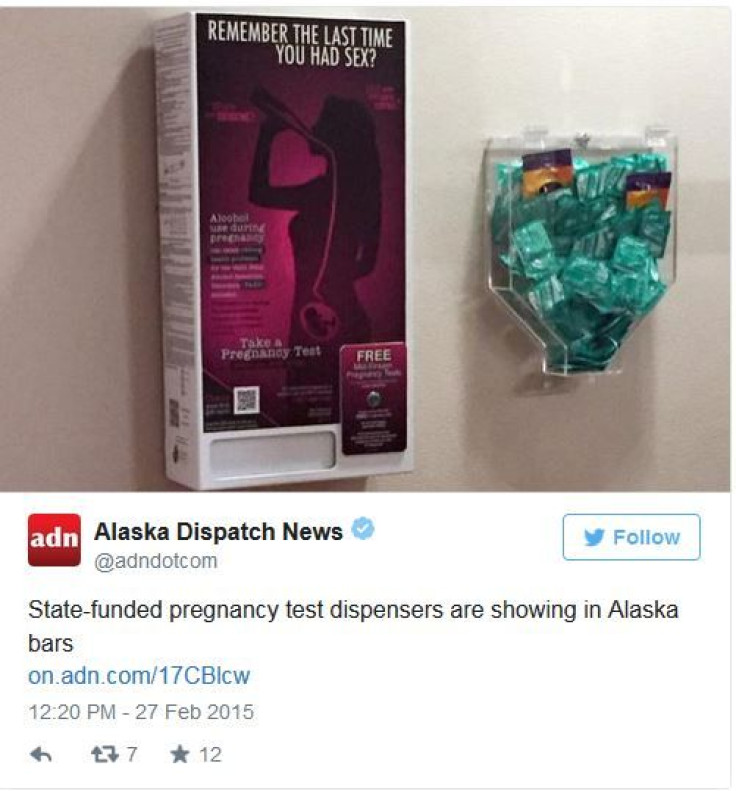Alaska Funds Free Pregnancy Tests In Bars To Prevent Fetal Alcohol Syndrome: Why Native Americans Are More Vulnerable

At Anchorage’s Peanut Farm Bar and Grill a wall dispenser hangs in the women’s bathroom, reports Alaska Dispatch News. A sign across the machine's face reads: “Remember the last time you had sex? Take a pregnancy test before you drink tonight.” Simply press the button and out pops a free pregnancy test.
In addition to the $400,000 Alaska is spending on these dispensers, some portion of $600,000 which subsidizes the non-profit First Alaskans Institute will be devoted to counseling pregnant women who drink, and another half a million dollars of state funds will go to a public awareness campaign warning women about fetal alcohol spectrum disorders (FASD).
Why is Alaska, which faces a multibillion-dollar budget shortfall (according to the Alaska Journal of Commerce), breaking the bank on this public health message?
The state suffers from higher than average rates of fetal alcohol syndrome, due to the fact that Native Americans are more vulnerable to alcohol-related conditions, experts say, than other ethnic groups.
What is FASD?
Fetal alcohol spectrum disorders (FASD) is an umbrella term that includes fetal alcohol syndrome, alcohol-related neurodevelopmental disorder, and alcohol-related birth defects. As a term FASD is intended to simply describe the range of effects, including physical, mental, behavioral, and/or learning disabilities that sometimes occur when a baby is exposed to alcohol while still in the womb.
In particular, fetal alcohol syndrome is a diagnosable condition with three major components: distinctive facial features, growth deficiencies, and brain damage. Diagnosis of fetal alcohol syndrome is based on several physical and developmental abnormalities. The cognitive and behavioral symptoms and issues linked to fetal alcohol syndrome include mental retardation, learning disabilities, attention deficits, hyperactivity, poor impulse control, and social, language, and memory deficits.
While diagnosis of the syndrome may be relatively clear, coming up with the exact number of affected people is not.
Difficult Numbers
Some studies benchmark the fetal alcohol syndrome rate for the general population at about 2.2 births per 1,000, while in-person assessments of school children suggest the syndrome affects from six to nine out of 1,000 children. Meanwhile, a National Institutes of Health report claims the rate of fetal alcohol syndrome for some native tribes may range as high as 10.3 per 1,000 people.
The figures for FASD are even less precise. Several different approaches to measuring population incidence have been used, still the website for the Centers for Disease Control and Prevention simply states: “We do not know exactly how many people have fetal alcohol spectrum disorders.” Having said that, the CDC clocks prevalence of the three underlying conditions of FASD combined at (at least) one percent of all births, while noting experts who have looked at studies with physical examinations say FASD may affect up to five percent of the total population.
No matter, one number is obvious: This disorder is 100 percent preventable and Alaska has made national headlines by addressing this health issue.
Barroom Testing
The pregnancy test vending machine in the Peanut Farm is actually part of an academic study that poses a simple question: Do posters warning women against drinking while pregnant work better when plastered to dispensers or simply framed on the wall? Dr. David Driscoll, director of the University of Alaska Anchorage’s Institute of Circumpolar Health Studies, told Alaska Dispatch News that he and his team will install up to 19 more dispensers-plus-signs and will hang stand-alone posters in other alcohol-serving businesses across the state in the coming weeks. To encourage participation in the survey portion of the study, $15 iTunes gift cards will be given to those who visit a website or call a toll-free number and answer questions related to the FASD messaging.

Though this study may seem unusual, Alaska is not the first state to roll-out pregnancy test dispensers. A Minnesota nonprofit installed similar dispensers in bars, convenience stores, and one youth center, while California and Ohio made their own trial runs. (The manufacturer of the vending machines is unknown.)
Alaska's roll-out of dispensers will be a first in that public health researchers also will attempt to gauge their effectiveness compared to stand-alone posters. Though some might criticize this effort as wasteful, others believe the fanfare surrounding the dispensers will help achieve the bottom line: reducing the number of children with FASD by raising public awareness.



























